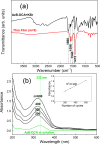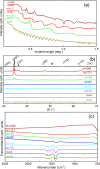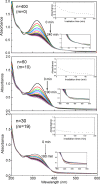Reversible Photoswitching Function in Atomic/Molecular-Layer-Deposited ZnO:Azobenzene Superlattice Thin Films
- PMID: 30319176
- PMCID: PMC6179458
- DOI: 10.1021/acs.chemmater.8b01833
Reversible Photoswitching Function in Atomic/Molecular-Layer-Deposited ZnO:Azobenzene Superlattice Thin Films
Abstract
We report new types of reversibly photoresponsive ZnO:azobenzene superlattice thin films fabricated through atomic/molecular-layer deposition (ALD/MLD) from diethylzinc, water, and 4,4'-azobenzene dicarboxylic acid precursors. In these ultrathin films, crystalline ZnO layers are interspersed with monomolecular photoactive azobenzene dicarboxylate layers. The thickness of the individual ZnO layers is precisely controlled by the number (m) of ALD cycles applied between two subsequent MLD cycles for the azobenzene layers; in our {[(Zn-O) m +(Zn-O2-C-C6H4-N=N-C6H4-C-O2)] n +(Zn-O) m } samples, m ranges from 0 to 240. The photoresponsive behavior of the films is demonstrated with ultraviolet-visible spectroscopy; all the films are found to be photoreactive upon 360 nm irradiation, the kinetics of the resultant trans-cis photoisomerization somewhat depending on the superlattice structure. The reversibility of the photoisomerization reaction is then confirmed with a subsequent thermal treatment. Our work thus provides proof-of-concept evidence of the suitability of the ALD/MLD technology for the implementation of photoactive moieties such as azobenzene within an inorganic matrix as an attractive new methodology for creating novel light-switchable functional materials.
Conflict of interest statement
The authors declare no competing financial interest.
Figures







References
-
- Que W. X.; Yao X.; Liu W. G. Azobenzene-Containing Small Molecules Organic-Inorganic Hybrid Sol-Gel Materials for Photonic Applications. Appl. Phys. B: Lasers Opt. 2008, 91, 539–543. 10.1007/s00340-008-2988-4. - DOI
-
- Hu D.; Lin J.; Jin S.; Hu Y.; Wang W.; Wang R.; Yang B. Synthesis, Structure and Optical Data Storage Properties of Silver Nanoparticles Modified with Azobenzene Thiols. Mater. Chem. Phys. 2016, 170, 108–112. 10.1016/j.matchemphys.2015.12.025. - DOI
-
- Spiridon M. C.; Iliopoulos K.; Jerca F. A.; Jerca V. V.; Vuluga D. M.; Vasilescu D. S.; Gindre D.; Sahraoui B. Novel Pendant Azobenzene/Polymer Systems for Second Harmonic Generation and Optical Data Storage. Dyes Pigm. 2015, 114, 24–32. 10.1016/j.dyepig.2014.10.010. - DOI
LinkOut - more resources
Full Text Sources
